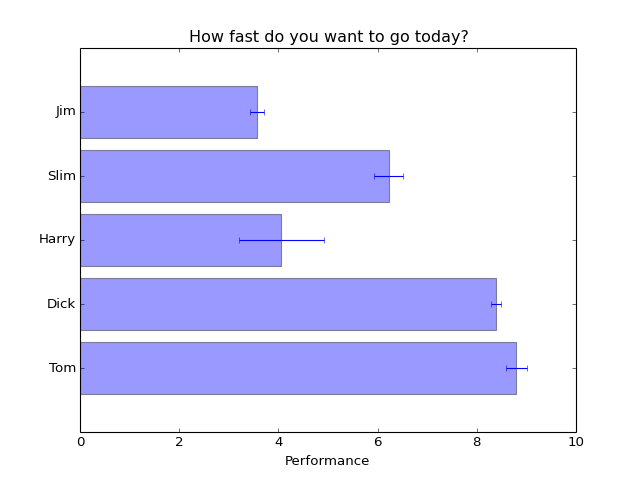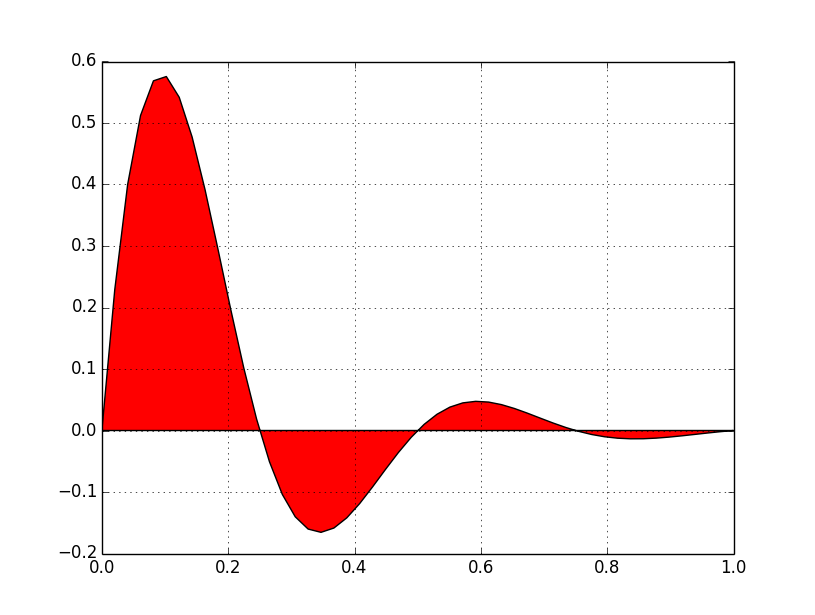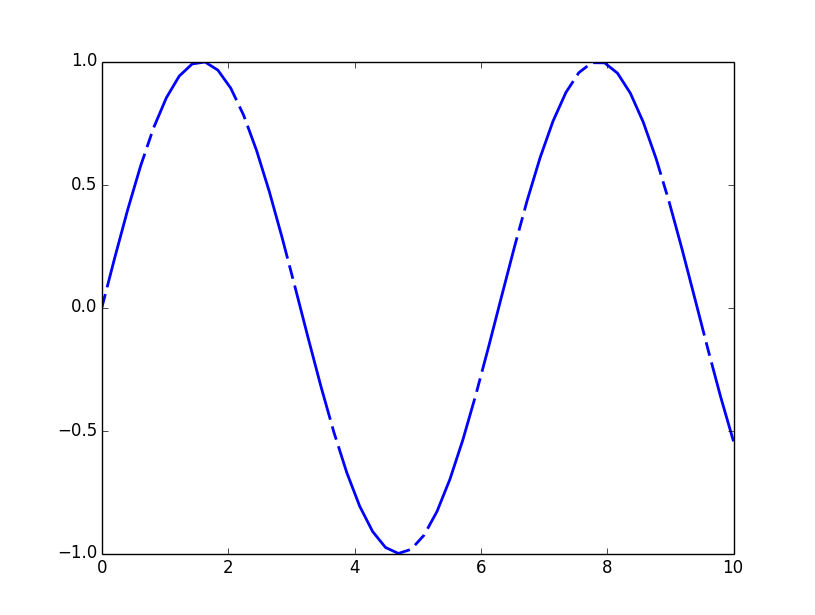目录
###1.水平柱状图 lines bars and markers example code: barh demo.py

1
2
3
4
5
6
7
8
9
10
11
12
13
14
15
16
17
18
19
20
21
22
23
24
25
#coding:utf-8
"""
Simple demo of a horizontal bar chart.
"""
import matplotlib.pyplot as plt; plt.rcdefaults()
import numpy as np
import matplotlib.pyplot as plt
# Example data
people = ('Tom', 'Dick', 'Harry', 'Slim', 'Jim')#定义一组数据
y_pos = np.arange(len(people))#arange类似range不过返回的是array
performance = 3 + 10 * np.random.rand(len(people))#随机生成每个人的表现
error = np.random.rand(len(people))
plt.barh(y_pos, performance,height=0.6,xerr=error, align='center', alpha=0.1)
#创建一个horizontal bar
"""barh(bottom, width, height=0.8, left=0, **kwargs)
bottom:底部坐标
width:横向长度
height:柱的宽度
"""
plt.yticks(y_pos, people)#y坐标
plt.xlabel('Performance')#x轴名称
plt.title('How fast do you want to go today?')#表名
plt.show()#显示图片
1.matplotlib.pyplot.rcdefaults()
Restore the default rc params. These are not the params loaded by the rc file, but mpl’s internal params. See rc_file_defaults for reloading the default params from the rc file
2.matplotlib.pyplot.barh(bottom, width, height=0.8, left=None, hold=None, **kwargs)
info:Make a horizontal bar plot
3.matplotlib.pyplot.yticks(*args, **kwargs)
4.matplotlib.pyplot.xlabel(s, *args, **kwargs)
5.matplotlib.pyplot.title(s, *args, **kwargs)
1.np.arange()
To create sequences of numbers, NumPy provides a function analogous to range that returns arrays instead of lists
2.np.random.rand()
###2.填充曲线 lines bars and markers example code: fill demo.py

1
2
3
4
5
6
7
8
9
10
11
12
13
#coding:utf-8
"""
Simple demo of the fill function.
"""
import numpy as np
import matplotlib.pyplot as plt
x = np.linspace(0, 1)#0-1等步长
y = np.sin(4 * np.pi * x) * np.exp(-5 * x)#sin(4*pi*x)*x^-5
plt.fill(x, y, 'r') #使用红色填充填充
plt.grid(True) #打开网格
plt.show()
1.matplotlib.pyplot.fill(*args, **kwargs)
2.plt.grid(True)
###3.多图叠加 lines bars and markers example code: fill demo features.py

1
2
3
4
5
6
7
8
9
10
11
12
13
14
15
16
17
18
19
#coding:utf-8
"""
Demo of the fill function with a few features.
In addition to the basic fill plot, this demo shows a few optional features:
* Multiple curves with a single command.
* Setting the fill color.
* Setting the opacity (alpha value).
"""
import numpy as np
import matplotlib.pyplot as plt
x = np.linspace(0, 2 * np.pi, 100)#(0,2*pi),100等分
y1 = np.sin(x)
y2 = np.sin(3 * x)
plt.fill(x, y1, 'b', x, y2, 'r', alpha=0.3)#把两个曲线画在一张图上
#plt.grid(True)
plt.show()
###4.虚线和自定义虚线 lines bars and markers example code: line demo dash control.py

1
2
3
4
5
6
7
8
9
10
11
12
13
14
15
16
17
#coding:utf-8
"""
Demo of a simple plot with a custom dashed line.
A Line object's ``set_dashes`` method allows you to specify dashes with
a series of on/off lengths (in points).
"""
import numpy as np
import matplotlib.pyplot as plt
x = np.linspace(0, 10)#0-10等步长
line, = plt.plot(x, np.sin(x), '--', linewidth=2)
dashes = [10, 5, 100, 5] # 10 points on, 5 off, 100 on, 5 off 设置长横和短横
line.set_dashes(dashes)#按照dashes自定义虚线
plt.show()
1.line.set_dashes(dashes)
2.plt.plot(x, np.sin(x), '--', linewidth=2)
info:.plot
本文采用中国大陆版CC协议发布
作者保留以下权利:
- 署名(Attribution):必须提到原作者。
- 非商业用途(Noncommercial):不得用于盈利性目的。
- 禁止演绎(No Derivative Works):不得修改原作品, 不得再创作。
新浪微博 @XX含笑饮砒霜XX
